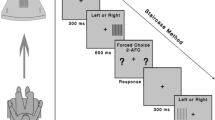Summary
Static visual acuity has been measured as a function of target exposure time; dynamic visual acuity as a function of target velocity. The ranges were 6–120 msec for flash exposures and 22–167°/sec for angular velocities. Frequency of seeing curves were used to determine thresholds for two groups of observers, aged 20–30 years and 40–50 years.
Visual acuity is found to deteriorate rapidly with angular velocity. The product-moment correlation and the correlation ratio were calculated in order to reveal any relation between static and dynamic visual acuity. There is no statistically significant relationship between these two types of visual discrimination abilities either in a linear or a curvilinear fashion.
Quantification of visual performance in terms of equal resolving power of the eye for a target velocity and corresponding momentary target exposure is found to be possible only up to 60°/sec.
A senile decline in acuity was observed; dioptric factors of the eye are shown to have more far reaching consequences than any age effect associated with the function of the oculomotor system.
Similar content being viewed by others
References
Behrens, C.: The retina: its role in speed of perception. Amer. J. Ophthal.45, 675–683 (1958).
Burg, A.: Visual acuity as measured by dynamic and static tests: a comparative evaluation. J. appl. Psychol.50, 460–466 (1966).
Elkin, E. H.: Target velocity, exposure time and anticipatory tracking time as determinants of dynamic visual acuity. J. Eng. Psychol.1, 26–33 (1962).
Hulbert, S. F., Burg, A., Knoll, H. A., Mathewson, J. H.: A preliminary study of dynamic visual acuity and its effects in motorist's vision. J. Amer. Optom.29, 359–364 (1958).
Ludvigh, E. J., Miller, J. W.: The effects on dynamic visual acuity of practice at one angular velocity on the subsequent performance at a second angular velocity. Joint project Report No. NM 001 110.501.09 Pensacola, Florida. Kresge Eye Institute of Detroit and U.S. Naval School of Aviation Medicine (1955).
——: Study of visual acuity during the ocular pursuit of moving test objects. I. Introduction. J. opt. Soc. Amer.48, 799–802 (1958).
Ratliff, F.: The role of physiological nystagmus in monocular acuity. J. exp. Psychol.43, 163–172 (1952).
Reading, V. M.: Disability glare and age. Vision Res.8, 207–214 (1968).
Riggs, L. A., Armington, J. C., Ratliff, F.: Motions of the retinal image during fixation. J. opt. Soc. Amer.44, 315–321 (1954).
Thomson, L. C.: The influence of variations in the light history of the eye upon the course of its dark adaptation. J. Physiol. (Lond.)109, 430–438 (1949).
Weale, R. A.: The Aging Eye. London: H. K. Lewis 1963.
Weissman, S., Freeburne, C. M.: Relationship between static and dynamic visual acuity. J. exp. Psychol.70, 141–146 (1965).
Author information
Authors and Affiliations
Additional information
This work formed part of a Ph.D. thesis approved by the University of London.
Rights and permissions
About this article
Cite this article
Reading, V.M. Visual resolution as measured by dynamic and static tests. Pflugers Arch. 333, 17–26 (1972). https://doi.org/10.1007/BF00586038
Received:
Issue Date:
DOI: https://doi.org/10.1007/BF00586038




